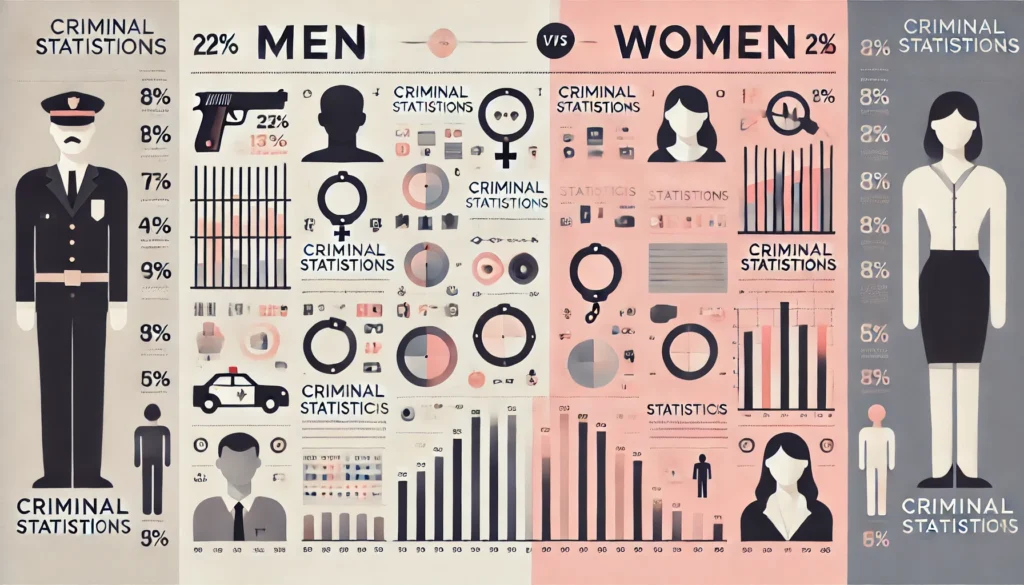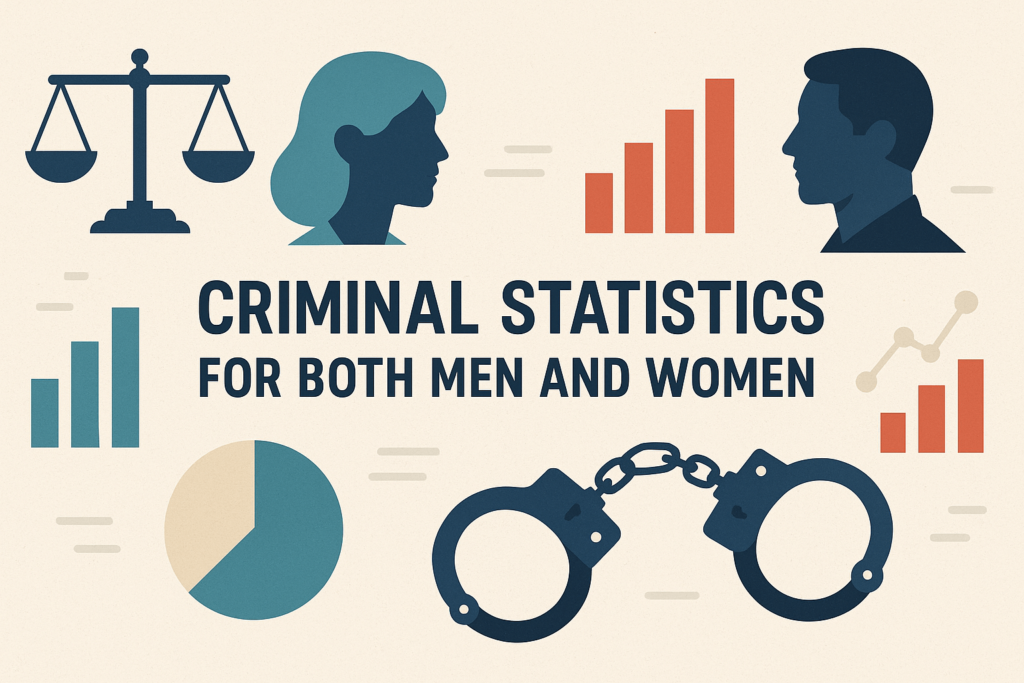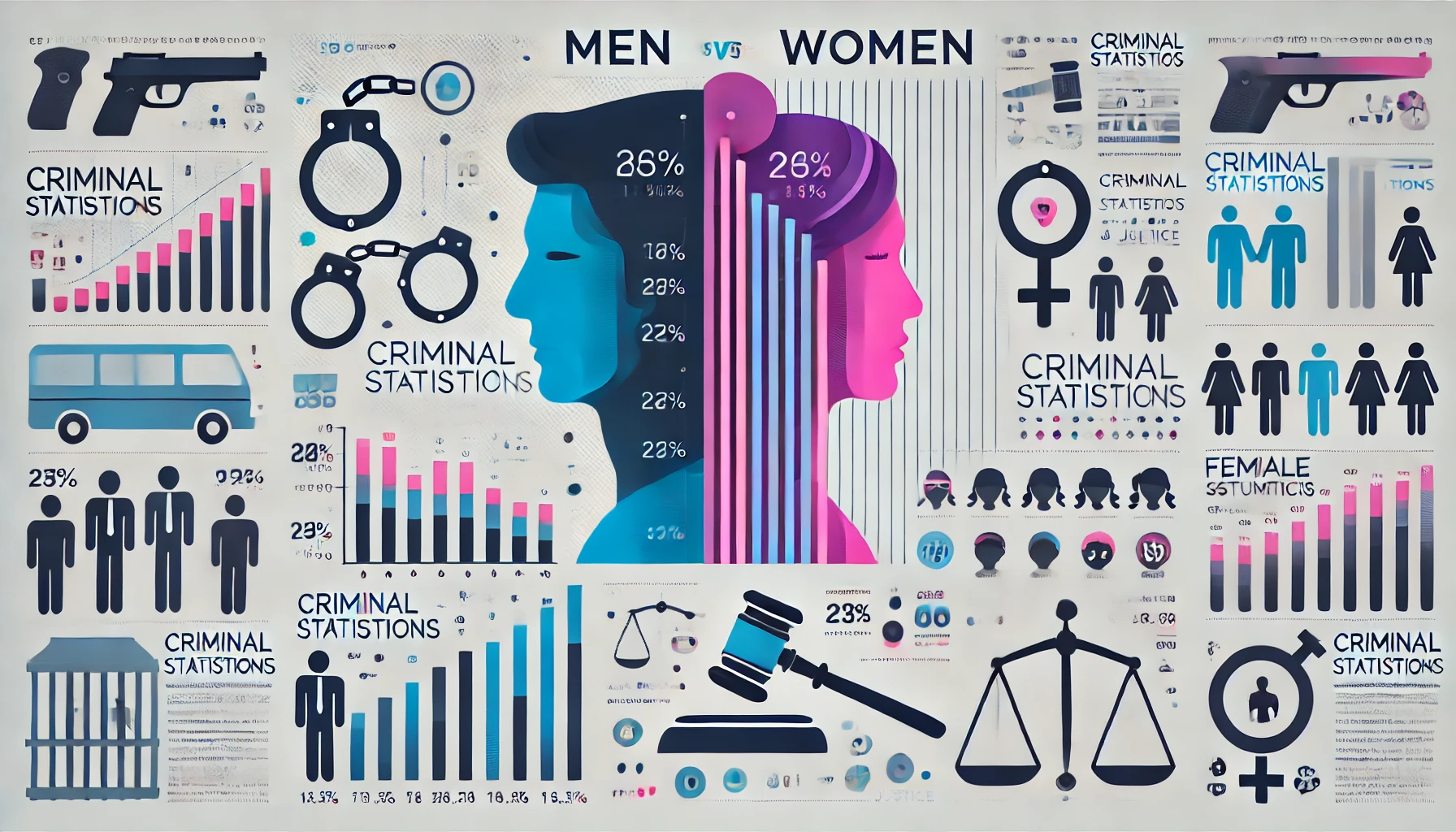Introduction
- Hook: Crime is a universal phenomenon, but the rates and types of crimes committed by men and women show notable differences worldwide.
- Thesis Statement: This article analyzes criminal statistics for both genders, highlighting key differences, patterns, and the sociological and psychological factors that influence these trends.
Understanding crime through the lens of gender not only reveals behavioral trends but also sheds light on systemic issues within law enforcement and the justice system. Recognizing the underlying causes of gender disparities in crime statistics helps policy makers and researchers develop more effective, inclusive solutions.
1. Global Crime Statistics: An Overview
- General Crime Rates:
- Men commit significantly more crimes than women worldwide (approx. 80% of all crimes).
- Women’s involvement in crime has shown a gradual increase over the past decades, especially in non-violent offenses.
- Common Crimes by Gender:
- Men: Violent crimes (e.g., assault, murder).
- Women: Non-violent crimes (e.g., theft, fraud).
Regional differences also shape how gendered crime manifests. For instance, in Nordic countries with higher gender equality indices, the gap between male and female offenders is narrower compared to patriarchal societies. Moreover, in countries experiencing political instability or economic crisis, the participation of women in criminal activity may spike due to survival needs.
2. Violent Crimes
- Men’s Predominance:
- Homicide: Men are responsible for nearly 90% of homicides globally.
- Assault: Higher rates of physical violence among men.
- Women and Violent Crimes:
- Domestic violence and infanticide as notable exceptions.
- Motivations often linked to self-defense or psychological distress.
Cultural norms often discourage women from committing acts of overt violence, but in gang-affiliated environments, this dynamic shifts. Female gang members, especially in Latin America and inner-city communities, are increasingly engaging in acts of violence to prove loyalty or rise in rank. These shifts challenge traditional gender assumptions about aggression.
3. Property and Financial Crimes
- Theft and Burglary:
- Men are more likely to engage in high-stakes thefts (e.g., armed robbery).
- Women’s involvement in shoplifting and small-scale thefts.
- Fraud and Embezzlement:
- Women are increasingly implicated in white-collar crimes.
- Motivations often tied to economic necessity or familial responsibilities.
Technological advancement has also expanded women’s role in digital and financial crimes. Cases of women involved in cyber fraud, online scams, and credit card theft have risen, showing a shift from traditional, physical property crimes to more covert, tech-driven offenses that require less physical confrontation.
4. Substance-Related Crimes
- Drug Trafficking and Abuse:
- Men dominate in drug production and trafficking.
- Women often play secondary roles or act as couriers due to coercion or economic need.
- Alcohol-Related Offenses:
- Men: Higher rates of drunk driving and public intoxication.
- Women: Increasing trends in alcohol-related crimes in some regions.
Gender-specific stigmas often influence how substance abuse crimes are prosecuted. Women, for example, face greater social condemnation and often harsher penalties for drug offenses, especially when they are mothers. This adds an additional layer of discrimination that affects rehabilitation opportunities and sentencing outcomes.

5. Gender Differences in Recidivism Rates
- Men:
- Higher rates of re-offending, especially for violent crimes.
- Sociocultural factors such as peer influence and lack of rehabilitation.
- Women:
- Lower recidivism rates; crimes often motivated by situational factors.
- Importance of social support in preventing re-offense.
Men are often placed in harsher environments that lack proper psychological support, leading to higher chances of reoffending. On the other hand, women released from prison face unique challenges such as regaining custody of children or escaping abusive relationships, which can either deter or motivate further criminal behavior.
6. Sociological Explanations for Gender Differences in Crime
- Traditional Gender Roles:
- Men as risk-takers and aggressors due to societal expectations.
- Women’s roles as caregivers reducing opportunities for crime.
- Economic Disparities:
- How poverty and unemployment disproportionately drive crime in both genders.
- Socialization and Education:
- Differences in upbringing and education affecting criminal behavior.
Peer pressure and social networks differ greatly by gender. Young men may be drawn into crime through gang culture or peer validation, while women are more likely to commit crimes under the influence of intimate partners or familial obligations. This highlights the importance of context in criminal behavior.
7. Psychological and Biological Perspectives
- Aggression and Testosterone:
- Higher testosterone levels linked to increased aggression in men.
- Mental Health and Crime:
- Women more likely to suffer from mental health issues leading to crime.
- Postpartum psychosis and its role in infanticide.
Neurological studies suggest that the male brain is more inclined toward impulsive behavior, which may explain higher involvement in spontaneous or violent crimes. Meanwhile, hormonal fluctuations in women, especially during pregnancy or postpartum periods, can contribute to criminal behavior in rare but notable cases, such as neonaticide.
8. The Role of Women in Organized Crime
- Emerging Trends:
- Women’s growing involvement in organized crime networks.
- Case Studies:
- Female drug lords and leaders in trafficking operations.
In many regions, women act as facilitators in trafficking networks, using gender-based assumptions to avoid suspicion from authorities. For example, women are often used as drug mules or front figures in money laundering operations, exploiting societal perceptions that women are less likely to be criminals.
9. Criminal Victimization by Gender
- Men:
- Higher victimization rates for violent crimes.
- Women:
- Predominantly victims of sexual violence and domestic abuse.
Victimization patterns are not only gendered but intersect with age, ethnicity, and sexual orientation. Young men are often victims of street violence or gang-related aggression, while LGBTQ+ women face heightened risks of both sexual and physical violence. Understanding these intersections is key to victim support.
10. Efforts to Address Gender-Specific Crime Patterns
- Gender-Sensitive Policies:
- Rehabilitation programs tailored for women offenders.
- Addressing toxic masculinity to reduce violent crimes.
- Global Initiatives:
- UN and other organizations working to reduce gender disparities in crime and victimization.
There is growing momentum for trauma-informed approaches in criminal justice, especially for female offenders who are often survivors of abuse. Additionally, re-education campaigns aimed at young boys are being implemented in schools to challenge toxic masculinity and reshape future attitudes toward crime and violence.

11. The Scientific Value of Criminal Statistics
Criminal statistics serve as an essential foundation for empirical research in criminology, sociology, psychology, and public policy. By systematically collecting and analyzing crime data, researchers can identify patterns, test hypotheses, and evaluate the effectiveness of laws and interventions. These statistics allow for comparisons across time, regions, and demographic groups, helping us understand the root causes of crime and the effectiveness of crime prevention strategies.
Moreover, scientific analysis of criminal statistics provides policymakers with evidence-based insights. For example, if a spike in youth crime is detected, governments can invest in youth outreach programs or educational initiatives. Similarly, a rising trend in cybercrime can inform the need for more advanced digital security laws and international cooperation.
Criminal statistics are also crucial in ensuring transparency and accountability within the justice system. They help in identifying discriminatory practices, such as racial profiling or gender-based disparities in sentencing, by offering quantifiable evidence that advocates and reformers can use to push for systemic change.
12. How Criminal Statistics Influence Public Perception of Crime
Public perception of crime is often shaped not by personal experience but by media portrayal and selective exposure to criminal statistics. When certain crimes are highlighted—such as violent offenses committed by men or high-profile female criminals—it can skew public understanding and create fear or bias that isn’t necessarily supported by data.
Criminal statistics, when accurately presented, help correct these misconceptions. For instance, while violent crimes may dominate headlines, data often shows that property crimes and non-violent offenses are far more prevalent. Understanding this helps communities prioritize actual safety concerns rather than perceived threats.
In addition, governments and law enforcement agencies use criminal statistics to guide public communication strategies. For example, if data shows a rise in domestic violence, campaigns can be launched to raise awareness, encourage reporting, and promote support resources.
Ultimately, educating the public about how to interpret criminal statistics can lead to a more informed and engaged society—one that pushes for reforms, supports fair policies, and actively participates in creating safer communities.
Conclusion
- Summary: The stark differences in criminal statistics for men and women stem from biological, psychological, and sociological factors.
- Reflection: Understanding these patterns can inform better crime prevention strategies and equitable criminal justice policies.
In the long term, integrating gender perspectives into criminal statistics and justice systems can reduce bias, promote rehabilitation, and ensure that prevention strategies are equitable. Continued research is essential to uncover evolving patterns in gendered crime and to foster a more inclusive approach to justice.

